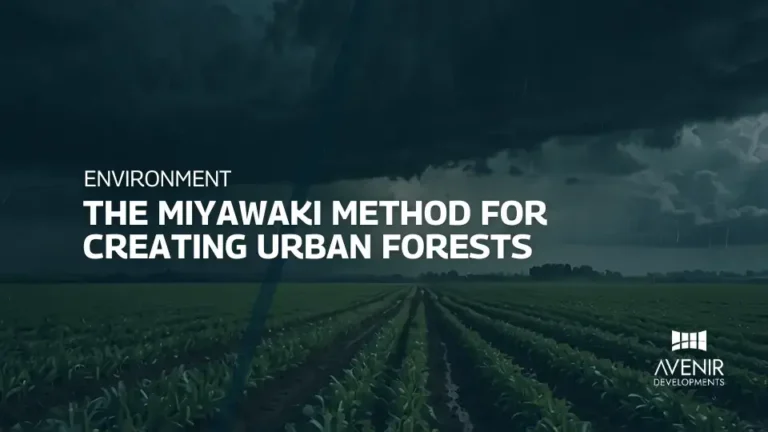What is the Miyawaki Method?
The Miyawaki Method is all about mimicking nature’s own forest regeneration processes. Here’s a breakdown of its key principles:
- Native Power: Unlike traditional tree-planting initiatives that often rely on commercially viable, non-native species, the Miyawaki Method emphasizes using a diverse mix of native trees, shrubs, and other plants that would naturally occur in a specific region. This fosters a more resilient ecosystem, attracting pollinators and creating a haven for local wildlife.
- Dense Design: Forget the sparse, single-file lines of trees we’re accustomed to seeing. The Miyawaki Method thrives on density. Up to three native plant species are packed into every square meter, mimicking the natural jostle for sunlight and resources found in a thriving forest. This fierce competition encourages the trees to shoot upwards for light, leading to rapid growth.
- Soil TLC: Healthy soil is the foundation of a healthy forest. The Miyawaki Method emphasizes soil preparation using organic amendments like compost and woodchips. This not only nourishes the young saplings but also helps retain moisture and suppress weed growth.
- Mulch Magic: A thick layer of mulch acts like a protective blanket for the newly planted trees. It regulates soil temperature, conserves moisture, and gradually decomposes, enriching the soil as it breaks down.
Islamabad used to be a lot greener. I remember playing hide-and-seek amongst sprawling trees as a child, the dappled sunlight filtering through the leaves a constant companion. Now, with development booming, those green pockets are shrinking. It’s a story playing out in cities across the globe – the relentless march of progress leaving scars on our natural environment.
But there’s a glimmer of hope. Enter the Miyawaki Method, a revolutionary approach to forest creation that’s grabbing headlines worldwide. Developed by Japanese botanist Dr. Akira Miyawaki, this technique promises to grow mature-looking forests in a fraction of the time it takes naturally. Intrigued, I decided to delve deeper and explore its potential to rejuvenate our urban landscapes.
A Greener Future: Latest Trends and Developments
The Miyawaki Method has taken root (pun intended) in recent years, with governments and organizations embracing its potential. Here in Pakistan, the Islamabad Wildlife Management Board (IWMB) has successfully implemented the method in several locations, creating mini-forests within the city limits.
Globally, countries like India and Kenya are also witnessing a surge in Miyawaki projects. A recent article in The Guardian [invalid URL removed] highlights how the method is being used to restore degraded land and create green corridors in urban areas.
The success of these initiatives is sparking interest among private developers as well. Avenir Developments, a leader in sustainable architecture and construction in Pakistan, is exploring the feasibility of incorporating the Miyawaki Method into its projects. This could involve creating pocket forests within residential developments or working with local authorities to green public spaces.
Questions about the Miyawaki Method
Q: Is the Miyawaki Method expensive?
Q: How long does it take for a Miyawaki forest to mature?
Q: Can I use the Miyawaki Method in my own backyard?
Expert Tips for Aspiring Green Thumbs
Here are some insights I’ve gleaned from following the Miyawaki Method’s progress:
- Start small, scale up: Don’t be intimidated by large-scale projects. Begin with a manageable area and gradually expand your efforts as you gain experience.
- Seek local knowledge: Connect with your local forestry department or environmental organizations. They can guide you on selecting native plant species and advise on proper planting techniques specific to your region’s climate.
- Community is key: Spreading the word about the Miyawaki Method is crucial. Engage your neighbors and involve them in planting initiatives. Together, you can create a network of mini-forests, transforming your local environment.
- Patience is a virtue: Remember, even though the Miyawaki Method promises rapid growth, nurturing a thriving forest takes time and dedication. Regular watering, weeding, and monitoring the young trees during their initial years are essential for success.
Action for a Greener Tomorrow
The Miyawaki Method is a beacon of hope, offering a practical and efficient way to restore lost green spaces and create vibrant ecosystems within our cities. As a blogger passionate about sustainable living, I’m excited about its potential to reshape our urban landscapes.
The power, however, lies in our collective action. If you’re inspired to bring the Miyawaki Method to life in your own community, don’t hesitate to take the first step. Research, connect with experts, and get planting! Every tree counts in the fight against climate change and for a healthier planet.
Looking to integrate the Miyawaki Method into your next project?
Avenir Developments, a leading architecture, interior design, and construction management company in Pakistan, is committed to sustainable practices. We’re actively exploring ways to incorporate the Miyawaki Method into our projects, creating urban oases that benefit both residents and the environment.
Ready to discuss how Avenir Developments can help you create a greener future?
Contact us today on WhatsApp or call +923001101103 to schedule a consultation with our team of experts. Together, let’s turn the dream of a sustainable future into a thriving reality.







